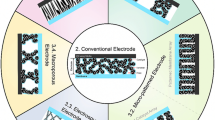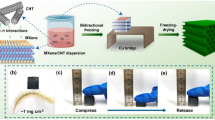Abstract
In this study, a novel core-shell silica@carbon nanofiber (SiO2@C) is successfully prepared via coaxial electrospinning technique with optimized parameters followed by heat treatment. The characterizations of the nanofiber are carried out by a combination of X-ray diffraction measurement, electrical conductivity test, tensile test, thermogravimetric analysis, nitrogen isotherm adsorption-desorption analysis, mechanical strength test, and water uptake measurement. It is found that the hygroscopic mesoporous SiO2 is contained in a core and the hydrophobic electron-conductive carbon is in a shell that has porous channels. The BET surface area, pore volume, electrical conductivity, mechanical strength, and water uptake of SiO2@C are all superior to that of pure carbon nanofiber. These superior properties make SiO2@C a potential microporous layer (MPL) material, benefitting the water management ability of proton-exchange membrane fuel cells (PEMFCs). The result of the single-cell performance tests shows that under 99.9% or 15% relative humidity (RH) in the temperature range of 50–80 °C, the power densities of the PEMFC fabricated with the SiO2@C-based MPL are all significantly higher than that of the pure carbon nanofiber-based MPL, and 66~302% higher than that of the traditional hydrophobic carbon black powder-based MPL. This study indicates that the as-prepared novel core-shell SiO2@C nanofiber is a promising MPL material for PEMFC.









Similar content being viewed by others
References
Wang Y, Chen KS, Mishler J, Cho SC, Adroher XC (2011) A review of polymer electrolyte membrane fuel cells: technology, applications, and needs on fundamental research. Appl Energy 88(4):981–1007
Yan WM, Hsueh CY, Soong CY, Chen F, Cheng CH, Mei SC (2007) Effect of PTFE loading of gas diffusion layers on the performance of proton exchange membrane fuel cells running at high-efficiency operating conditions. Int J Hydrog Energy 32(17):4452–4458
Zhang LW, Chae SR, Hendren Z, Park JS, Wiesner MR (2012) Recent advances in proton exchange membranes for fuel cell applications. Chem Eng J 204-206:87–97
Stassi A, Gatto I, Passalacqua E, Antonucci V, Arico AS, Merlo L, Oldani C, Pagano E (2011) Performance comparison of long and short-side chain perfluorosulfonic membranes for high temperature polymer electrolyte membrane fuel cell operation. J Power Sources 196(21):8925–8930
Tu Z, Zhang H, Luo Z, Liu J, Wan Z, Pan M (2013) Evaluation of 5 kW proton exchange membrane fuel cell stack operated at 95 °C under ambient pressure. J Power Sources 222:277–281
Tsai CH, Lin HJ, Tsai HM, Hwang JT, Chang SM, Chen-Yang YW (2011) Characterization and PEMFC application of a mesoporous sulfonated silica prepared from two precursors, tetraethoxysilane and phenyltriethoxysilane. Int J Hydrog Energy 36(16):9831–9841
Tsai CH, Wang CC, Chang CY, Lin CH, Chen-Yang YW (2014) Enhancing performance of Nafion®-based PEMFC by 1-D channel metal-organic frameworks as PEM filler. Int J Hydrog Energy 39(28):15696–15705
Vinothkannan M, Kim AR, Gnana kumar G, Yoo DJ (2018) Sulfonated graphene oxide/Nafion composite membranes for high temperature and low humidity proton exchange membrane fuel cells. RSC Adv 8(14):7494–7508
Peighambardoust SJ, Rowshanzamir S, Amjadi M (2010) Review of the proton exchange membranes for fuel cell applications. Int J Hydrog Energy 35(17):9349–9384
Han RY, Wu PY (2018) Composite proton-exchange membrane with highly improved proton conductivity prepared by in situ crystallization of porous organic cage. ACS Appl Mater Interfaces 10(21):18351–18358
Holmström N, Ihonen J, Lundblad A, Lindbergh G (2007) The influence of the gas diffusion layer on water management in polymer electrolyte fuel cells. Fuel Cells 7(4):306–313
Prasanna M, Ha HY, Cho EA, Hong SA, Oh IH (2004) Influence of cathode gas diffusion media on the performance of the PEMFCs. J Power Sources 131(1-2):147–154
Wang XL, Zhang HM, Zhang JL, Xu HF, Zhu XB, Chen J, Yi BL (2006) A bi-functional micro-porous layer with composite carbon black for PEM fuel cells. J Power Sources 162(1):474–479
Tang HL, Wang SL, Pan M, Yuan RZ (2007) Porosity-graded microporous layers for polymer electrolyte membrane fuel cells. J Power Sources 166(1):41–46
Chun JH, Jo DH, Kim SG, Park SH, Lee CH, Lee ES, Jyoung JY, Kim SH (2013) Development of a porosity-graded micro porous layer using thermal expandable graphite for proton exchange membrane fuel cells. Renew Energy 58:28–33
Chun JH, Park KT, Jo DH, Lee JY, Kim SG, Park SH, Lee ES, Jyoung JY, Kim SH (2011) Development of a novel hydrophobic/hydrophilic double micro porous layer for use in a cathode gas diffusion layer in PEMFC. Int J Hydrog Energy 36(14):8422–8428
Kitahara T, Nakajima H, Okamura K (2015) Influence of hydrophilic and hydrophobic triple MPL coated GDL on the oxygen transport resistance in a PEFC under high humidity conditions. ECS Trans 69(17):1313–1322
Tanuma T, Kinoshita S (2014) Impact of cathode fabrication on fuel cell performance. J Electrochem Soc 161(1):F94–F98
Shrestha P, Banerjee R, Lee J, and Bazylak A (2017) Hydrophilic microporous layer coatings for polymer electrolyte membrane fuel cells. Proceedings of the 4th International Conference of Fluid Flow, Heat and Mass Transfer (FFHMT'17) DOI: https://doi.org/10.11159/ffhmt17.137
Schweiss R, Steeb M, Wilde PM (2010) Mitigation of water management in PEM fuel cell cathodes by hydrophilic wicking microporous layers. Fuel Cells 10(6):1176–1180
Tanuma T (2010) Innovative hydrophilic microporous layers for cathode gas diffusion media. J Electrochem Soc 157(12):B1809–B1813
Kitahara T, Nakajima H, Mori K (2012) Hydrophilic and hydrophobic double microporous layer coated gas diffusion layer for enhancing performance of polymer electrolyte fuel cells under no-humidification at the cathode. J Power Sources 199:29–36
Kitahara T, Nakajima H, Inamoto M, Morishita M (2013) Novel hydrophilic and hydrophobic double microporous layer coated gas diffusion layer to enhance performance of polymer electrolyte fuel cells under both low and high humidity. J Power Sources 234:129–138
Kitahar T, Nakajima H, Inamoto M, Shinto K (2014) Triple microporous layer coated gas diffusion layer for performance enhancement of polymer electrolyte fuel cells under both low and high humidity conditions. J Power Sources 248:1256–1263
Wang J, Tang J, Xu YL, Ding B, Chang Z, Wang Y, Hao XD, Dou H, Kim JH, Zhang XG, Yamauchi Y (2016) Interface miscibility induced double-capillary carbon nanofibers for flexible electric double layer capacitors. Nano Energy 28:232–240
Song MJ, Shin MW (2014) Fabrication and characterization of carbon nanofiber@mesoporous carbon core-shell composite for the Li-air battery. Appl Surf Sci 320:435–440
Mao XW, Hatton T, Rutledge GC (2013) A review of electrospun carbon fibers as electrode materials for energy storage. COC 17(13):1390–1401
Zhixin J, Yongyi Y, Gang J (2011) Preparation and characterization of co/PAN-based carbon fibrous composites. Eur Phys J Appl Phys 55(1):10404
Chen YL, Hu Y, Shen Z, Chen RZ, He X, Zhang XW, Li YQ, Wu K (2017) Hollow core-shell structured silicon@carbon nanoparticles embed in carbon nanofibers as binder-free anodes for lithium-ion batteries. J Power Source 342:467–475
Park S, Lee JW, Popov BN (2006) Effect of carbon loading in microporous layer on PEM fuel cell performance. J Power Sources 163(1):357–363
Park S, Lee JW, Popov BN (2008) Effect of PTFE content in microporous layer on water management in PEM fuel cells. J Power Sources 177(2):457–463
Lin HL, Yu TL, Shen KS, Huang LN (2005) Effect of Triton-X on the preparation of Nafion/PTFE composite membranes. J Membr Sci 237:1–7
Pirzada T, Arvidson SA, Saquing CD, Shah SS, Khan SA (2014) Hybrid carbon silica nanofibers through sol−gel electrospinning. Langmuir 30(51):15504–15513
Bhardwaj N, Kundu SC (2010) Electrospinning: a fascinating fiber fabrication technique. Biotechnol Adv 28(3):325–347
Colomer MT, Rubio F (2016) Textural characteristics, degree of protonation, water uptake and proton transport properties relationships in colloidal sol-gel derived micro- and mesoporous silica membranes. Int J Hydrog Energy 41(13):5748–5757
Duan Q, Wang B, Wang J, Wang H, Lu Y (2010) Fabrication of a carbon nanofiber sheet as a micro-porous layer for proton exchange membrane fuel cells. J Power Sources 195(24):8189–8193
Funding
The authors would like to thank the Ministry of Science and Technology, Taiwan, R.O.C. for supporting the research work under grant MOST 103-2113-M-033-002 and the Chung Yuan Christian University for supporting the research work.
Author information
Authors and Affiliations
Corresponding author
Ethics declarations
Conflict of interest
The authors declare that they have no conflict of interest.
Additional information
Publisher’s note
Springer Nature remains neutral with regard to jurisdictional claims in published maps and institutional affiliations.
Electronic supplementary material
ESM 1
(DOCX 375 kb)
Rights and permissions
About this article
Cite this article
Lee, HF., Wang, PC. & Chen-Yang, Y.W. An electrospun hygroscopic and electron-conductive core-shell silica@carbon nanofiber for microporous layer in proton-exchange membrane fuel cell. J Solid State Electrochem 23, 971–984 (2019). https://doi.org/10.1007/s10008-019-04198-5
Received:
Revised:
Accepted:
Published:
Issue Date:
DOI: https://doi.org/10.1007/s10008-019-04198-5




